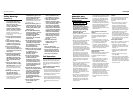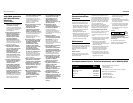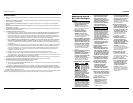
24 Sp
Manual de Instrucciones
Advertencias de
seguridad generales
para herramientas
eléctricas
(continuación)
b) No use la herramienta
eléctrica si el interruptor no
la enciende y la apaga.
Cualquier herramienta eléctrica
que no pueda ser controlada con
el interruptor es peligrosa y
debe repararse.
c) Desconecte el enchufe de la
fuente de energía y/o la
batería de la herramienta
eléctrica antes de hacer
cualquier ajuste, cambiar
accesorios o guardar
herramientas eléctricas.
Dichas medidas de seguridad
preventivas reducen el riesgo de
que la herramienta eléctrica se
active por accidente.
d)Guarde las herramientas
eléctricas que no estén en
uso fuera del alcance de los
niños y no permita que
personas que no estén
familiarizadas con la
herramienta eléctrica o con
estas instrucciones la usen.
Las herramientas eléctricas son
peligrosas cuando están en
manos de usuarios inexpertos.
e)Realice el mantenimiento a
las herramientas eléctricas.
Verifique que las piezas
móviles no estén
desalineadas ni adheridas,
que no haya piezas rotas y
que no exista ningún otro
problema que pueda afectar
el funcionamiento de la
herramienta eléctrica. Si está
dañada, haga reparar la
herramienta eléctrica antes
de usarla. Muchos accidentes
son causados por herramientas
eléctricas que no tienen un
mantenimiento adecuado.
f) Mantenga sus herramientas
para cortar afiladas y limpias.
Es menos probable que las
herramientas de corte con un
mantenimiento adecuado y con
bordes de corte afilados se
atasquen y además son más
fáciles de controlar.
g)Use los accesorios, las brocas
y puntas, etc. de la
herramienta eléctrica de
acuerdo con estas
instrucciones, teniendo en
cuenta las condiciones de
trabajo y el trabajo a realizar.
El uso de la herramienta eléctrica
para funciones diferentes de
aquellas para las que fue
diseñada puede provocar una
situación peligrosa.
h)Cuando la batería no está en
uso, manténgala alejada de
los objetos metálicos como
sujetadores de papel,
monedas, llaves, clavos,
tornillos u otros objetos
similares para que no exista
un riesgo de que los
terminales de la batería
queden conectados entre sí
(es decir en “cortocircuito”).
Hacer un puente entre los
terminales de la batería puede
provocar chispas, quemaduras,
incendios, choque eléctrico o
daños a la batería.
i) No la use si las mordazas del
portabrocas u otras piezas
están partidas o desgastadas.
j) Verifique la rotación del
taladro antes de comenzar a
taladrar/atornillar, para que
sea la correcta para la
operación que se va a
realizar.
k)No use el taladro como una
buriladora ni trate de alargar
o agrandar agujeros
torciendo el taladro. Las
brocas del taladro pueden
quebrarse y provocar
lesiones.
l) Cada taladro está equipado
con un portabrocas capaz de
manejar brocas de hasta
cierto tamaño. Para el
taladro DG20419, no se
deben usar brocas con
diámetros de eje mayores de
3/8 pulg. (10 mm).
m) Asegúrese de que el
interruptor esté en la
posición de apagado antes
de introducir la batería.
Introducir la batería en
herramientas eléctricas con el
interruptor en la posición de
encendido favorece la ocurrencia
de accidentes.
n)Recargue la betería
únicamente con el cargador
que se proporciona con esta
herramienta. Un cargador
adecuado para un tipo de
batería puede provocar un
riesgo de incendio cuando se usa
con otra batería.
o)Use este taladro únicamente
con la batería que se
proporciona o con la batería
de repuesto recomendada
según las especificaciones del
fabricante. El uso de cualquier
otra batería puede crear un
riesgo de lesiones o incendio.
p)Cargue la batería en un área
bien ventilada. No permita
que ningún objeto cubra el
cargador ni la batería
mientras está cargando.
q)No haga funcionar el
cargador de la batería si su
enchufe o cable están
dañados. Si estos
componentes están dañados,
haga que una persona
calificada en reparación los
reemplace de inmediato.
r) No haga funcionar el
cargador si se ha caído, ha
recibido un golpe fuerte, o ha
sido dañado de otra manera.
Si está dañado, haga que una
persona calificada en
reparación le realice un
servicio.
General Driving
Screws Instructions
(Continued)
Removing Screws
In order to remove a screw from a
workpiece, use the following steps:
• Set the clutch adjusting collar to its
highest setting and set the speed
selector to its lowest "1" setting.
• Install the proper screwdriver bit
into the drill’s chuck.
• Fully depress the REV button.
• Place the screwdriver bit in the screw
head and with enough pressure
exerted on the drill so that it doesn’t
jump out of the screw head, start
the drill to remove the screw.
Maintenance
Cleaning
All plastic parts should be cleaned with
a soft damp cloth. NEVER use solvents
to clean plastic parts. They could
dissolve or otherwise damage the
material.
Failure to Start
Should your tool fail to start, make
sure the battery pack is charged and
installed in the drill.
Battery Service
The battery pack supplied with this
drill will self-discharge and lose some
of its capacity over time. Therefore, if
it is stored unused for a long period of
time, then it may require recharging
before use. In order to get the most
out of your batteries, it is
recommended that the pack be
recharged every 2-3 months and when
doing so, remove the pack from the
charger after 2-3 hours of charging.
Removing/Replacing the Chuck
If there is a need to replace the chuck,
use the following steps to do so:
• Remove the battery pack from the
drill.
• Rotate the clutch collar until its drill
bit symbol aligns with the arrow on
the top of the drill housing.
• Open the chuck jaws fully by
unscrewing the chuck sleeve
counterclockwise (when viewing the
chuck from its end).
• Locate the left-handed screw inside
the chuck and with the proper
screwdriver bit and remove this
screw by turning it clockwise.
• Insert the short arm of a 3/8" hex
key or Allen wrench into the chuck
and tighten the jaws of the chuck on
the flats of this wrench.
• With a hammer or the like, strike the
long arm of the wrench sharply so
that the chuck will turn
counterclockwise.
• Once the chuck has been loosened,
remove the wrench and unscrew the
chuck from its spindle.
• To replace the chuck with another
one, reverse the steps noted above.
Always keep the spindle threads,
chuck threads, and securing screw
free of debris.
Service
Tool
service
must be performed only by qualified
repair personnel and by an
AUTHORIZED SERVICE CENTER. Service
or maintenance performed by
unqualified personnel could result in a
risk of injury.
For information regarding the
operation or repair of this product,
please call 1-800- 424-8936.
9
For Replacement Parts or Technical Assistance, call 1-800-424-8936
Please provide following information:
- Model number
- Serial number (if any)
- Part description and number as shown in parts list
Part
Description Number
Address any correspondence to:
Campbell Hausfeld
Attn: Parts Department
100 Production Drive
Harrison, OH 45030 U.S.A.
Charger – 19.2V DG029600AV
Battery Pack – 19.2V DG201900AV
Chuck – 3/8" DG029900AV
Set Screw SX173400AV
Case DG030000AV
DG201900CK


















